Draw a Box Tikz Latex
There is a variety of different toolsets for creating graphical objects in a TeX document. The almost well known and probably almost widely used of these toolsets is Ti1000Z, which is a recursive acronym for "TithousandZ ist kein Zeichenprogramm" (German for TigrandZ is non a cartoon programme). From the name of the toolset you tin see that generating a figure in Ti1000Z will not work through drawing the figure like you might be familiar with doing in Paint or similar drawing programmes. To create a figure using Ti1000Z you will demand to code it by using specific TeX commands. We will take a look at the nuts of TikZ here.
Three useful references and sources of inspiration for creating TiyardZ figure are:
- The Wikibooks entry on TithousandZ: https://en.wikibooks.org/wiki/LaTeX/PGF/TikZ.
- The CTAN entry on Ti1000Z with the official handbook and other documentation: https://www.ctan.org/pkg/pgf.
- The TeXample TithouZ database full of examples and inspiration: https://texample.net/tikz/.
Building blocks of TikZ
To create a effigy in TichiliadZ you lot will first demand to load the correct bundle in your TeX file, i.eastward. use \usepackage{tikz} in the preamble. In that location is a wide range of options and special TithouZ libraries which tin too be used and would need to be loaded specifically, but we volition non need these in this beginner course. You lot can look at the available options and attempt them out yourself using the three references given above.
A TikZ figure is ordinarily placed in a \begin{figure} LaTeX environment, as you lot would do with other figures. This is useful considering information technology will let yous to requite the figure a number and caption, so that y'all will be able to reference it easily. Within your figure environment y'all can beginning a TikZ figure by writing the code \brainstorm{tikzpicture}, later on which you can start typesetting your figure. Equally usual y'all close the surroundings with the code \finish{tikzpicture}.
Unlike yous are used to when typesetting text and mathematics in LaTeX, y'all will demand i character which does not correspond directly to something yous can see in your document. Every line of TikZ lawmaking must be closed with a semicolon.
Let us get started by typesetting a graph, step by step, in TiyardZ. At the end of this lesson we will be able to typeset the following figure.
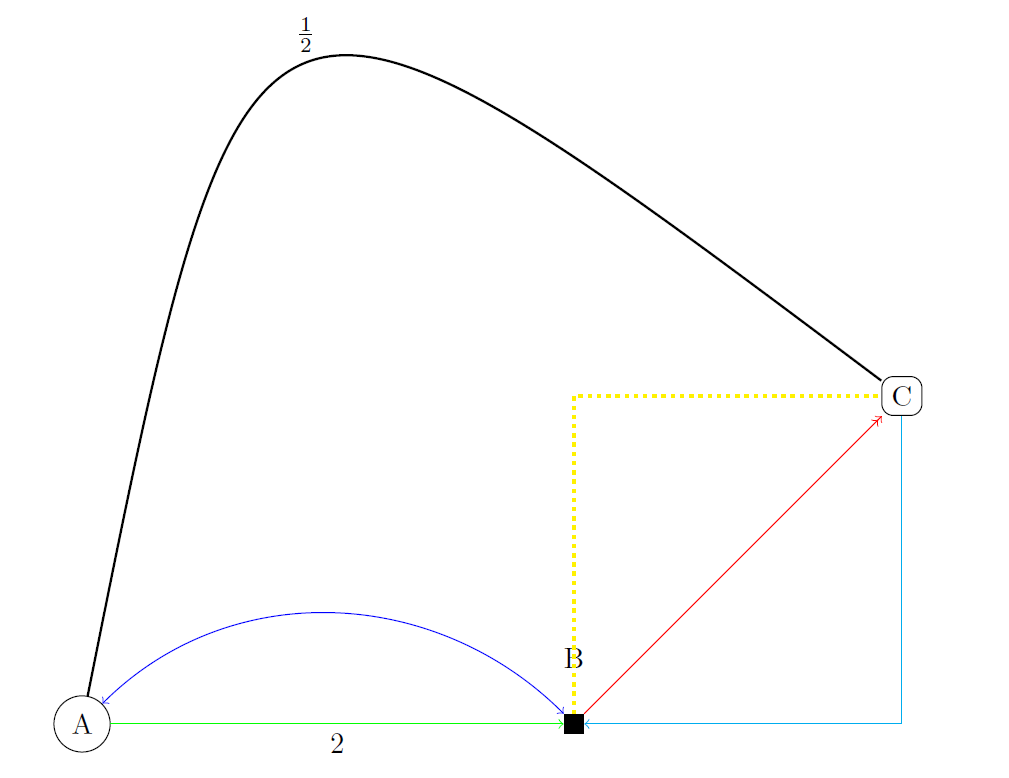
Drawing lines
A graph consists of several points and lines. We showtime the drawing of a graph by defining the coordinates of the points. In TikZ this can exist done in two different ways. A cartesian coordinate is given by ii numbers (an ten- and a y-coordinate) separated by a comma, and surrounded by circular brackets, so (-two,0) or (1.5,i.5). In TikZ coordinates can also exist given in polar form. This also works by giving 2 numbers within round brackets (the angle in degrees, and the length), this time separated past a colon, and then (180:2) or (45:2.1) for (approximately) the same two coordinates. Note: when no unit of measurement is given the default is centimeters, coordinates tin can as well be given every bit (1cm, 2pt) for example.
Nosotros can now describe direct straight lines between these coordinates using the \draw command.
\begin{tikzpicture} \draw (-1,0) -- (iii,10pt) -- (35:3); \end{tikzpicture} The event of this code is the following image.
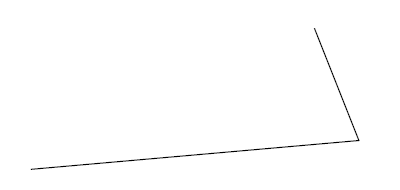
Autonomously from the drawing of direct direct lines, we can too define other types of lines, and these lines can be given color, line thickness, or pattern. For example, use -| or |- in stead of -- to draw lines that go horizontal first and so vertical, or the other way around. The style of the lines tin can exist inverse by giving options to the \draw control. This is done by putting these options in square brackets behind the control. In the following example we draw an arrow in stead of a line, and requite another line a colour.
\brainstorm{tikzpicture} \draw [->] (-1,0) -| (three,10pt); \depict [reddish] (iii,10pt) -- (35:3); \end{tikzpicture} The result of this code is the following image.
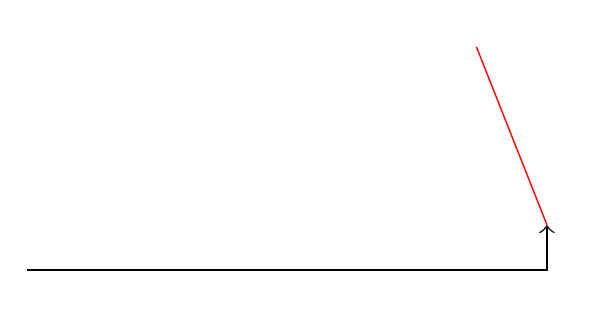
Utilize the TithouZ sources to see which types of options are possible.
Nosotros can not simply describe direct lines, only also curved lines. This tin be done in several dissimilar ways. In the post-obit example we nowadays three options.
\begin{tikzpicture} \draw (-1,0) to (5,1); \draw [green] (-1,0) to[out=90,in=135] (5,ane); \draw [cyan] (-1,0) .. controls (0,-2) .. (five,ane); \finish{tikzpicture} The result of this code is the following image.

The first thing that you might notice is the utilise of to in stead of -- to connect the coordinates together. This command works in exactly the same way, but when using to we can add options to the connecting command. For the dark-green line nosotros give two options, firstly the angle (in degrees) at which the line departs from the first coordinate, and secondly the angle at which the line arrives at the second coordinate. The blueish line is a so chosen Bézier bend, this is a line divers by its begin and end points together with a number of support points (in this case 1) that in upshot draw the line toward themselves. In TithouZ these types of lines can be defined with either one or two back up points. In the example below we requite the code to draw a Bézier curve with ii back up points.
\brainstorm{tikzpicture} \draw [dotted,gray] (-1,0) -- (v,ane); \draw (-one,0) .. controls (0,-two) and (four,ii) .. (5,1); \finish{tikzpicture} The result of this lawmaking is the following image.
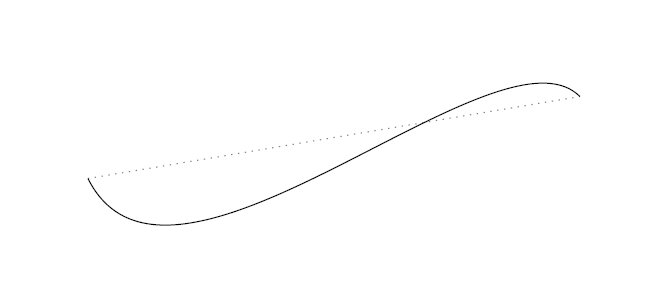
Nodes
The next step on the way to typesetting a graph are the labels, the bits of text and numbers that are contained in the figure. To write text in a Tione thousandZ effigy we need an object called a node. The simplest example of a node is some text which is placed on a given coordinate, but a node can besides exist a fleck of text surrounded by a circle, rectangle, or other simple shape. A node does non necessarily need to contain text, only for most cases text is the purpose of the node. A node can exist defined while drawing a path, which works equally follows:
\begin{tikzpicture}[scale=3] \draw (0,0) node {how-do-you-do} -- (1,1) node {earth}; \finish{tikzpicture} The result of this code is the following image.
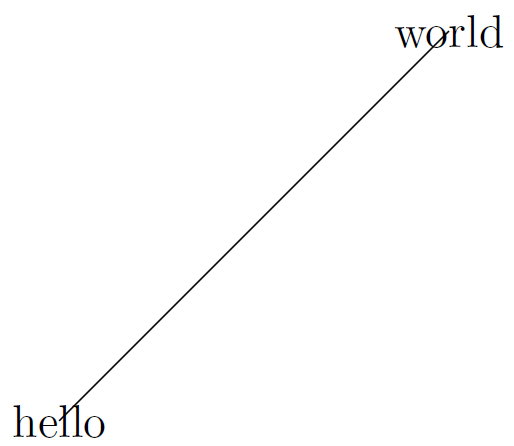
The option [scale=3] at the beginning of the figure increases the scale of the effigy with a cistron 3. The control node can also exist given options, for case to place a node in the middle of a line, at the end of a line, etc.
\begin{tikzpicture}[calibration=3] \depict (0,0) -- (ane,ane) node[midway]{A} node[pos=0.75,in a higher place]{B} node[correct]{C}; \stop{tikzpicture} The result of this code is the following image.
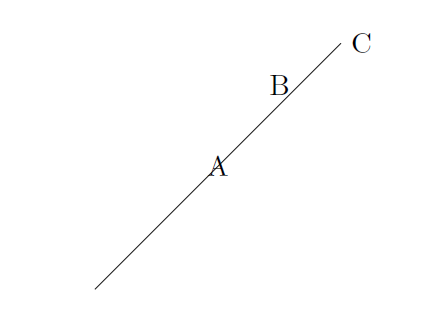
Delight annotation: when using the command to rather than --, the location of the node command changes slightly. This post-obit example code generates the aforementioned image as given above.
\begin{tikzpicture}[scale=3] \draw (0,0) to node[midway]{A} node[pos=0.75, above]{B} (1,one) node[right]{C}; \end{tikzpicture} Nodes tin can also be given mathematical formulae, and every bit has been said they tin can be bordered by a unproblematic shape.
\begin{tikzpicture}[scale=3] \draw (0,0) node[circle, draw]{$ \sum _{ i = 1 }^{ n } n ^ 2 $} -- (1,ane) node[rectangle,draw]{$ \frac { i }{ \sqrt { two }}$}; \end{tikzpicture} The outcome of this code is the following image.
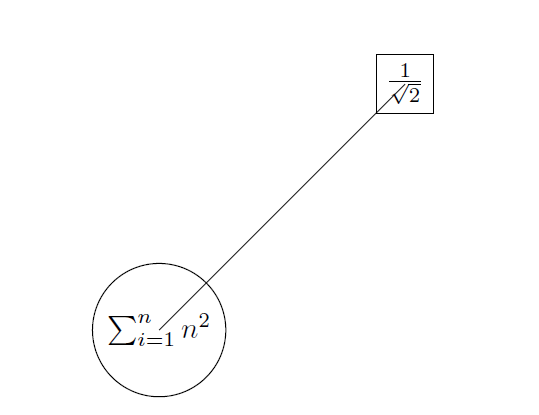
As you might have spotted, the line connecting the nodes still starts and ends exactly in the divers coordinates, which is non very pretty. This can be solved by predefining the nodes, and giving them a label, and so that we can draw the line from node to node.
\begin{tikzpicture}[scale=iii] % define nodes \node [circle,draw] (label1) at (0,0) {$ \sum _{ i = 1 }^{ due north } n ^ ii $}; \node [rectangle,describe] (label2) at (i,i) {$ \frac { i }{ \sqrt { 2 }}$}; % describe the line \draw (label1) -- (label2); \stop{tikzpicture} The result of this code is the following paradigm.
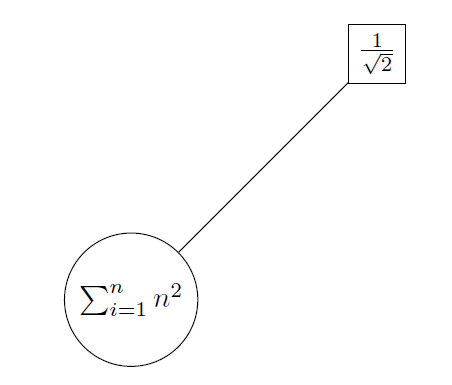
Nosotros accept now seen sufficient examples to understand how a graph can exist typeset in TikZ. The adjacent bit of lawmaking is the code used to generate the graph seen at the showtime of this lesson.
\begin{tikzpicture}[calibration=2] % Define the nodes \node [circle, describe] at (0,0) (a) {A}; \node [rectangle, fill] at (three,0) (b) {}; \node at (3,0.4) (blabel) {B}; \node [rectangle,rounded corners, describe] at (5,two) (c) {C}; % Draw the paths \describe [->, light-green] (a) -- (b) node[midway, beneath,blackness]{2}; \depict [<->, blue] (a) to[out=45, in=135] (b); \draw [->>,cerise] (b)--(c); \depict [yellow,dotted,very thick] (b) |- (c); \draw [<-,cyan] (b) -| (c); \draw [thick,blackness] (a).. controls (1,5) .. (c) node[midway, above]{$ \frac { 1 }{ ii }$}; \end{tikzpicture} Exercise 1
It is time to try some typesetting yourself. Open your favourite TeX editor and endeavour to typset graph beneath this exercise: The graph does non demand to look exactly the same equally the paradigm, the point is that yous are able to typeset a graph with similar properties. Hint: Information technology might aid to define the nodes in a circle using polar coordinates. You lot may copy this code for the document structure, so that you only need to focus on TikZ.
\documentclass [border=1cm] {standalone} \usepackage {tikz} \begin{document} \end{document} 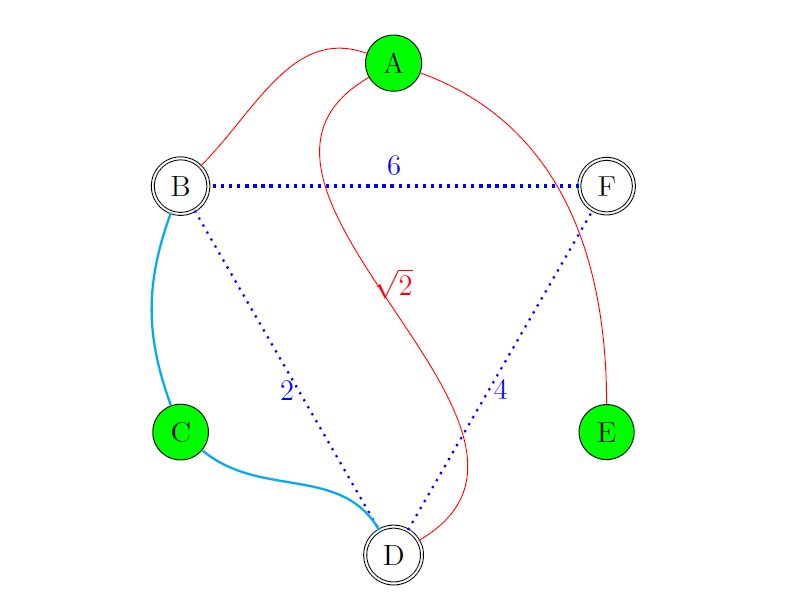
Plotting curves
Information technology is not merely possible to draw lines between coordinates in TikZ. In that location is also a built in manner to plot curves of a big range of unlike functions. For case the function $y = ten^2$ on the interval $[-2, two]$.
\begin{tikzpicture} \draw [domain=-2:two] plot (\ten, {pow(\ten,2}); \end{tikzpicture} The result of this lawmaking is the following image.
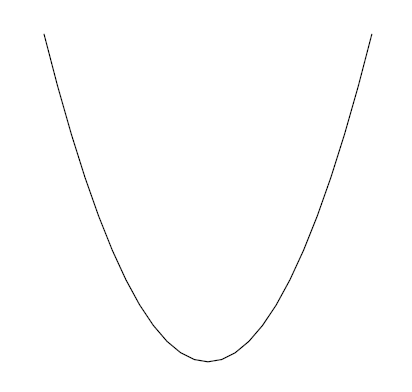
By using what you accept learned in the previous sections, you can add axes and labels to this bend. For instance:
\brainstorm{tikzpicture}[calibration=i.5] % Draw the x and y axis, label the axes and the origin \draw [greyness, ->] (-2,0) -- (2,0) node[right]{$ 10 $} node[pos=0.53, below]{$ O $}; \draw [gray, ->] (0,-i) -- (0,1) node[above]{$ y $}; \draw [fill,grayness] (0,0) circle [radius=1pt]; % Plot the curve \describe [bluish, thick] [domain=-2:2, samples=150] plot (\x, {cos(pi*\x r)}) node[right]{$ y = \cos ( x ) $}; % Note: the r in the argument of the cosine signifies that we enter \x in radians \stop{tikzpicture} The effect of this code is the following paradigm.
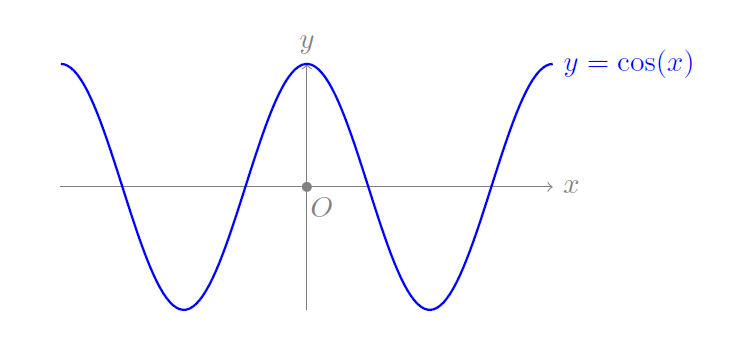
Practise ii
Endeavor to typset the plot following this practise. You may copy this code for the document structure, and so that you only demand to focus on TichiliadZ.
\documentclass [border=1cm] {standalone} \usepackage {tikz} \brainstorm{document} ... \terminate{certificate} 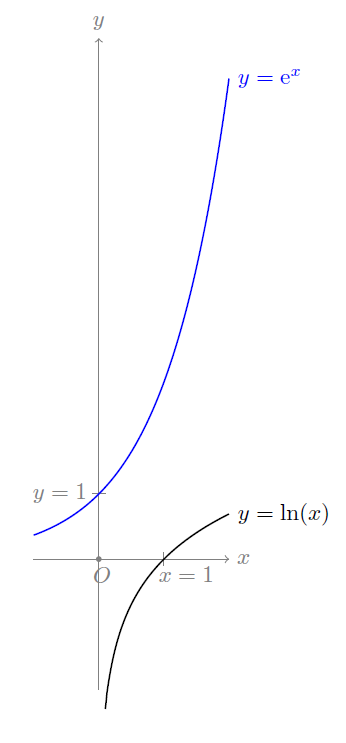
Working with loops
In TichiliadZ information technology is as well possible to make use of for loops, using \foreach ... in .... In this way, a fairly complicated epitome tin can exist typeset very quickly.
\begin{tikzpicture}[scale=0.75] \foreach \x in {0,1,ii,three} \draw [cherry-red,thick] (0,\x) circle [radius=\x+1]; \end{tikzpicture} The result of this code is the post-obit image.
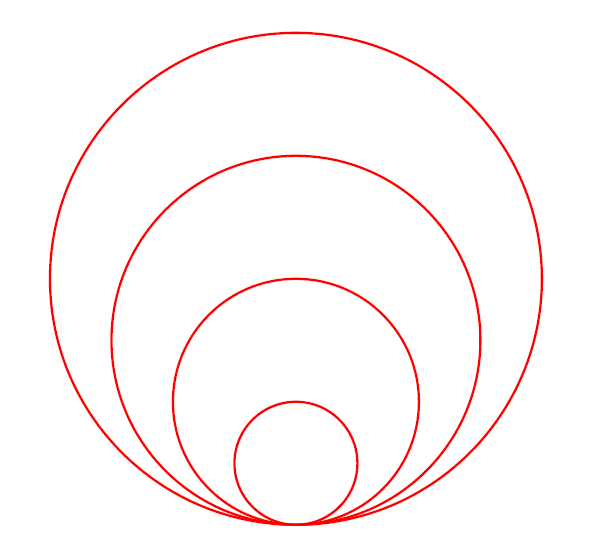
This idea is very useful for drawing iterative figures like Sierpiński'south triangle, although that does require a special TikZ library with which a recursive function can be divers. The following code gives the first half-dozen iterations of Sierpiński'due south triangle, drawn in TikZ. The code also contains some things in the preamble (before \begin{document}), and then we give the full LaTeX code for a pdf with just this figure in it.
\documentclass [border=1cm] {standalone} \usepackage {tikz} \usetikzlibrary {math} % Define a equilateral triangle with lower left corner at coordinate #1 and % with length of the sides #ii \newcommand\Triangle [2] { \draw #1 coordinate(a) -- ++(0:#ii) coordinate(b) ; \depict (a) -- ++(lx:#2) coordinate(c); \fill (a) -- (b) -- (c) -- bike; } \begin{document} \brainstorm{tikzpicture} \tikzmath { % Define the recursive role sierpinski office sierpinski(\x, \y, \s, \d) { if (\d == 0) and so { % Draw a triangle lower left corner at (\x, \y), length \s { \Triangle {(\x,\y)}{ \southward }; }; } else { % Rescale the length of the sides and choose correct coords % for the next triangles \u1 = 0.25*\s; \u2 = \ui*sqrt(3); \u3 = 0.5*\southward; sierpinski(\x,\y,\uthree,\d-1); sierpinski(\x+\u3,\y,\u3,\d-1); sierpinski(\x+\u1,\y+\u2,\u3,\d-1); }; }; % Let the length of the sides of the base of operations triangle be 4, and generate half-dozen figures \S = iv; for \d in {0,...,v}{ % To situate all plots nicely under and side by side to each other, define the coords % of the lower left corners preemptively \x = (\Due south+i)*mod(\d,ii); \y = int(\d/2) * (\S+1); sierpinski(\10,-\y,\S,\d); }; } \stop{tikzpicture} \finish{document} The result of this code is the following image.

Source: http://uva-fnwi.github.io/LaTeX/extra1/Tikz/